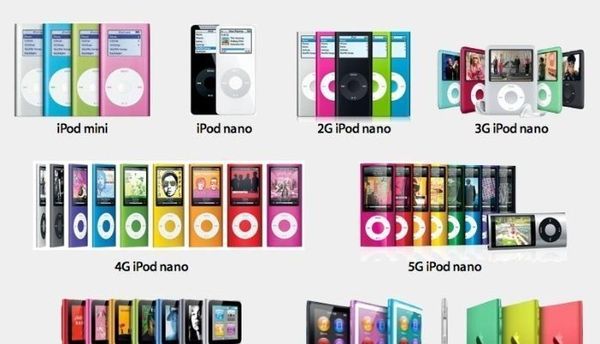I’ve noticed a pattern when it comes to the growth of certain popular products — both physical and media [1]. The pattern looks like this:
Company Develops a Breakthrough Product
A unique product hits the market. It looks or operates in a way that feels distinct in an important way. It’s aggressively different from other things on the market.
- iPod: bigger, heavier and more expensive than the tiny mp3 players on the market, but has a solid battery life and a massive amount of storage
- Vibrams: shoes that look like gorilla feet, but some people swear it gets rid of their knee pain / plantar fasciitis
- Marvel’s X-Men: a fictional team of superheros who are ordinary people with mutant abilities – depicted in comic books, tv shows, video games and movies
Product Gets Popular
Sometimes it launches to immediate success (iPod). Sometimes it sits around for a while before exploding (Vibrams). Sometimes it just takes years of steady growth in niche markets, until it eventually reaches mainstream (X-Men).
People are buying them off the shelves. Word of mouth is massive. Some people complain that it doesn’t work for them (too heavy, fit is too tight, want to see new heros/different storylines)
Company Expands Product Line
In a desire to grow sales, serve more customer segments and capture more market share, they start making a variety of versions of the product.
Apple expanded into different colors, and release smaller iPod nano, iPod shuffle products that are much more similar to the competitive Creative MuVo. Of course, eventually, Apple launches “widescreen iPod and breakthrough internet communication device” aka the iPhone.
As someone who bought my first pair of Vibrams four years ago, I’m a little overwhelmed by all the options there are today (here’s a screen grab of some of the shoes on Zappos). Most have a lot more cushion and padding than the earlier models.

Marvel dramatically expanded the X-Men franchise over the years, growing to a mind boggling number of different storylines, characters, spinoffs, and alternate timelines. In 1995 we had:
- X-Men
- X-Men Alpha
- Generation Next
- Astonishing X-Men
- X-Calibre
- Gambit & The X-Ternals
- Weapon X
- Amazing X-Men
- Factor X
- X-Man
- X-Men Omega
- Onslaught X-Men
- X-Factor
- Uncanny X-Men
- Wolverine
Growth Stalls Due to Expanded Product Line
Probably the most contentious and hardest prove part of this pattern is that I think the product sprawl really starts to confuse consumers. But I think it’s what happens in the long run.
All things considered, Apple has done a pretty good job of prioritizing their products (by having a flagship in front of everything else). But there are multiple iPhones and iPods to choose from today (in addition to iPads, Apple Watches, etc) and it can still be pretty confusing for consumers.
If I want people to try Vibrams, I have no idea what the right model to recommend. There are hiking, casual, running, crosstraining, and who knows what other type. I can’t say for sure that confusion is causing sales declines but things are not going so well for the business, at least from a mindshare perspective.
And as for Marvel, we think of them as a juggernaut today, but as reported in Vulture, the comic book industry was struggling massively, shrinking more than 70% down to a meager $270 million in sales in 1999 (from 1B in 1993)
Marvel especially was feeling the burn: It went through a humiliating Chapter 11 bankruptcy in the late ’90s, saw wave after wave of layoffs, and executive leadership was shuffled every few weeks. In 1999, after years of comics-publishing dominance, the company lost its top spot in industry market share and watched its rival, DC Comics, take the throne.
Company Has to Clean House or Reboot
As I mentioned, I think Apple is doing a pretty good job so far. But if we rewind the clock back to 1998, when Steve Jobs first took over as interim CEO, he famously cut 95% of the product line because it was so bloated. And when the new CEO of Nike called Jobs for advice, he was told to “get rid of the crappy stuff and focus on the good stuff”.
I really hope Vibrams does a house cleaning. I feel like they could cut down to 3 lines: a running line that’s got more foam, a thicker heavier shoe for hiking, trail runs, warmth, and finally a casual, walking, crosstraining, “beginner’s” shoe. Each could have regular and wide versions. It would make it easier to buy, and focus the team on making products that cover the major types of uses for Vibrams.
Marvel has probably the best story of cleaning house. They started with a reboot actually of Spiderman, starting the story over in 2000 with modern storylines, an emerging artist and writer team, and a teenage Peter Parker. They called it Ultimate Spiderman and it showed great promise. With that success came Ultimate X-Men, reverting the mutants back to angsty teens full of modern-day slang who need the guidance of a younger Professor Xavier. It was a hit.
Finally, in December, the buzz paid off and Ultimate Marvel hit the top of the comics sales charts. But it wasn’t with Ultimate Spider-Man. The first megahit Ultimate comic was the first issue of Ultimate X-Men, which sold a staggering 117,085 copies that month.

Of course, this set things up for Ultimate Avengers: the first issue of The Ultimates was the best-selling comic of the year, and the series basically became the playbook for Joss Whedon directed film years later.
The Ultimate experiment, the reboot, rescued Marvel from near death.
Concluding Thoughts
So what does all this mean? I think in general, it’s the problem with success: a simple product is clear, compelling, differentiated, and gets great initial uptick in the market. But as growth slows, there’s temptation to accommodate more needs, add more features, reach more customer segments. And that creates confusion, reduces the efficiency of creation / iteration, and increases the amount of upkeep needed to maintain.
People tend to be more comfortable adding things and making new things than they are to cut / edit things. So it’s easier to greenlight a new project than it is to shut down something. It may take a crisis or a big shift in management to generate the political will to reboot or clean house. But that’s a necessary thing to do.
Ultimately, recognizing the balance between focus, customization, and growth is an important thing for product managers, GM’s, and designers to recognize. Successful products will spawn all sorts of new activity, and result in expanded product lines, but the best creators know that they will eventually need to clear out too.
In other words, products are like redwood forests: they sometimes need a fire to keep growing.
Footnotes
[1] My caveat is that I think digital products are more resistant to this since you can personalize the experience much more for users and hide things that are not relevant. But it’s like a k factor that’s <1 in front of the equation, slows but does not stop the effect from still taking place. Software clutter is real.

